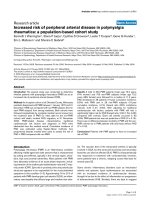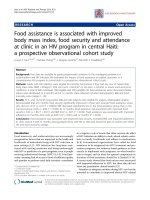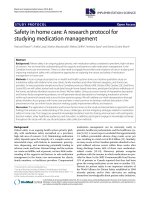face - saving strategies in teachers' oral feedback in english classrooms - a vietnamese - american cross-cultural study
Bạn đang xem bản rút gọn của tài liệu. Xem và tải ngay bản đầy đủ của tài liệu tại đây (1.75 MB, 112 trang )
VIETNAM NATIONAL UNIVERSITY, HANOI UNIVERSITY OF
LANGUAGES AND INTERNATIONAL STUDIES FACULTY OF
POST GRADUATE STUDIES
***
NGÔ THỊ PHƯƠNG LÊ
Face-Saving Strategies in Teachers’ Oral
Feedback in the English Classrooms: A
Vietnamese- American cross-cultural study
Field: English Linguistics
Code: 60.22.15
Combined Program
Supervisor: Prof. Nguyen Quang, Ph.D
HANOI, 2010
iv
Table of Contents
Acknowledgement …………………………………………………………… …………. ……… i
Declaration …………………………………………………………… … ii
Table of Contents ………………………….…………………………………………………… iii
List of Abbreviations ………………… ………………………………………………………… v
List of Tables .…………………………………………… vii
List of Figures and Charts ……………… ………………………………………………………viii
Abstract …………………………………………………………………………………………….ix
CHAPTER I INTRODUCTION 1
I. Rationale 1
II. Aims of the study 2
III. Scope of the study 2
IV. Method of the study 2
V. Organization of the study 3
CHAPTER II LITERATURE REVIEW 4
VI. Speech Acts 4
VII. Politeness Theory 6
II.1. The Notion of Politeness 6
II.2. The Notion of Face 7
II.3. Politeness Principles 8
II.3. Face-saving Strategies 12
II.3.1. Positive Politeness Strategies 12
II.3.1. Negative Politeness Strategies 22
VIII.Oral Feedback 29
CHAPTER III METHODOLOGY 31
I. Aims of the study 31
II. Research questions 31
v
III. Populations and Sampling: Participants 31
IV. Data Collection 32
IV.1. The Discourse Completion Tasks 32
IV.2. Data Collection Instruments 33
IV.3. The Administration of the Questionnaires 35
IV.4. Participants 35
IV.5. Data Analysis 36
CHAPTER IV DATA ANALYSIS AND DISCUSSIONS 39
I. Results and Discussions of the MPQ 39
I.1. Result of HaF 39
I.2. Result of HoF 43
I.3. Remarks 46
I.3.1. HaF 48
I.3.2. HoF 47
I.3.3. HaF vs. HoF 48
II. Results and Discussions of the DCT 51
II.1. FSSs Used in Teachers’ Oral Feedback to Students 51
II.2. Realization of FSSs in Teachers’ Oral Feedback 52
II.2.1. On- record 52
II.2.2. Give advice, suggestions 53
II.2.3. Make joke 53
II.2.4. Include both S and H in the activity 54
II.2.5. Encourage 54
II.2.6. Be conventionally indirect 55
II.2.7. Apologize 55
II.2.8. Impersonalize the S and the H 55
II.2.9. State the FTA as a general rule 56
vi
II.2.10. Go on record as incurring a debt, or as not indebting 56
II.2.11. Off - record 56
II.3. Use of Strategies as Seen from Types of Feedback 57
II.3.1. Corrective Feedback 58
II.3.2. Evaluative Feedback 63
II.3.3. Strategic Feedback 68
CHAPTER V CONCLUSION 74
I. Major findings 74
II. Choice of face saving strategy for types of feedback 74
III. Choice of FSSs in terms of feedback receiver 74
IV. Implications for English language teachers 75
V. Suggestions for further study 76
REFERENCES
APPENDICES
vii
LISTS OF
ABBREVIATIONS
Adv Advisable
ATs American
te
achers
CF Corrective Feedback
D Social Distance
DCT Discourse Completion Task
EF Evaluative Feedback
FTA Face-threatening Act
FSA Face-saving Act
FSS Face-saving Strategy
H The hearer
HaF Hit-all Feedback
HoF Hit-one Feedback
HAdv Highly Adv
i
sable
InAdv Inadvisable
MPQ Metapragmatic Questionnaire
N Number
NPS Negative Politeness Strategy
p Probability leve
l
P Relative power
PPS Positive Politeness Strategy
viii
R Relation
S The speaker
SInAdv Strongly Inadvisable
SF Strategic Feedback
SPSS Statistical Package for Social Sciences
Sig. Significance level
Sit. Situation
Str1 On-record strategy
Str2 Give advice and suggestions
Str3 Make joke
Str4 Include both S and H in the activity
Str5 Encourage
Str6 Be conventionally indirect
Str7 Apologize
Str8 Impersona
lize
Str9 State the FTA as a general rule
Str10 Go on record as incurring a debt, or as not indebting
Str11 Off-record strategy
VTs Vietnamese Teachers
Y/N Yes or No
ix
LIST OF
TABLES
Table 1
Informants’ status parameters
37
Table 2
Group statistics
38
Table 3
Independent Sample t test
39
Table 4
Categories of Feedback
40
Table 5
Assessment on Advisability of Situations for HaF by Vietnamese and American
41
Teachers
Table 6
Assessment on Advisability of Situations for HoF by Vietnamese and
44
American Teachers
Table 7 Summary of leading choices by VTs and ATs 51
Table 8 Summary of strategies used by VTs and ATs when giving oral feedbacks 52
Table 9
VT group Statistic for Strategies Used in CF Category
58
Table 10
AT group statistics for strategies used in CF Category
59
Table 11 AT & VT group statistics for strategies used for HaF in CF Category 61
Table 12 VT and AT group statistics for strategies used for HoF in CF 62
Table 13 Group statistics for Strategies used by VTs for EF 63
Table 14 Group statistics for Strategies used by ATs for EF 65
Table 15 Group statistics for Strategies used by VTs and ATs for HaF in EF Category 66
Table 16 Group statistics for strategies used by VTs and ATs for HoF in EF Category 68
Table 17 Group statistics for strategies used by VTs for HaF in SF Category 69
Table 18 Group statistics for strategies used by ATs for HaF in SF Category 70
Table 19 Group statistics for strategies used by VTs & ATs for HaF in SF Category 70
Table 20 Group statistics for strategies used by VTs & ATs for HoF in SF Category 72
x
LIST OF FIGURES AND
CHARTS
Figure 1
Selection of a strategy following an FTA, (Brown and Levinson, 1987)
10
Figure 2
Strategies to minimize risk of losing face (Nguyen Quang, 1999:30)
10
Figure 3 Brown and Levinson’s (1987) mechanisms for the realization of PPSs 21
Figure 4
Brown and Levinson’s (1987) mechanisms for the realization of NPSs
29
Chart 1
Choice of FSSs for HaF in CF Category by VTs and ATs
61
Chart 2
Choice of FSSs for HoF in CF Category by VTs and ATs
63
Chart 3
Choice of FSSs by VTs and ATs for HaF in EF Category
67
Chart 4 Choice of FSSs by VTs and ATs for HoF in EF Category 68
Chart 5 Choice of FSSs by VTs and ATs for HaF in SF Category 71
Chart 6 Choice of FSSs by VTs and ATs for HoF in SF Category 72
1
CHAPTER I. INTRODUCTION
I. Rationale
It has long been realized that the forms and uses of a given language reflect
the cultural values of the society in which the language is spoken. Linguistic
competence alone is not enough for learners of a language to be competent in that
language (Krasner, 1999). Therefore, together with learning and using a foreign
language, language users should deepen their understanding of its culture in order to
communicate successfully and appropriately.
It can be said that “politeness” is one of the most important categories in
communication and pragmatics study, especially in cross-cultural
communication/pragmatics. Politeness strategies are applied consciously and
unconsciously in communication in everyday social interaction. These strategies help
to make participants feel satisfied because their “face” is respected. This fact is much
truer in such high context culture as Vietnam.
Towards successful communication in the real world, some cross-cultural
studies such as requesting, refusing, thanking, apologizing have been conducted so far
to help Vietnamese students of English avoid confusion when expressing themselves.
As a teacher of English, the author has to do a lot of interactions with her students in
the class setting and thus, realizes some of the problems in communication between
teachers and students, among which is the uncomfortable and stressful feeling of
students when interacting. When the author attended some classes of American
teachers, she found it interesting when she realized that there are many differences
between the feedback that American and Vietnamese teachers give to their students.
For the above-mentioned reasons, the author conducts the study entitled
“Face-saving Strategies in Teachers’ Oral Feedback in English classrooms: A
Vietnamese – American cross-cultural study”. Such is her hope that her study will be
a contribution to the understanding of the nature of this activity across cultures.
II. Aims of the study
The aims of the study are:
2
To investigate the face-saving strategies used by American and Vietnamese
teachers when giving oral feedback to students in English classrooms.
To clarify major similarities and differences between American and Vietnamese
teachers when giving different types of feedback.
To provide implications in English Language Teaching and contribute to
increasing cross-cultural awareness among English language teachers and
learners.
III. Scope of the study
The study deals with verbal aspects of the act of giving feedback. The
Paralinguistic and non-verbal factors in communication are beyond the scope of this
study. Feedback itself can be given in the oral or written form. As it is a study on
face-to-face communication, the study focuses on oral form only. Besides, feedback
can be seen in the light of linguistics or teaching methodology; however, in this study,
only linguistics aspects are taken into account. Another point to be noticed is that a
feedback can be a positive or a negative evaluation on students‟ performance. Yet, in
this study, only feedbacks for negative performance, seen as obvious FTA, are
targeted. Last but not the least, only oral feedbacks produced by teachers in speaking
and writing sessions are examined in this study as they are considered as productive
skills while reading and listening are perceptive, thus, there are not many chances for
the diversification of feedback.
In short, the study especially focuses on face-saving strategies used by
teachers in giving oral feedback across Vietnamese and American languages and
cultures.
IV. Methodology
The research is conducted via quantitative and qualitative, descriptive and
comparative methods. The data was collected via questionnaires termed Discourse
Completion Tasks (DCT), which was logically and empirically validated before it is
used as a data collection instrument. The instrument used to construct validation of
the situations designed for the DCT is Metapragmatic Questionnaire (MPQ). Then
data will be analyzed using Independent Samples t-test and other functions of SPSS
15.0. (Methodology will be further detailed in Chapter III).
3
V. Organization of the study
The study will consist of the following parts:
Chapter I. Introduction
This chapter will introduce the rationale, aims, scope, and organization of the
study.
Chapter II: Literature Review
Theoretical background relevant to the topic and critical survey of related
articles, books and other resources will be presented.
Chapter II: Methodology
This chapter presents the detailed procedure of the study: the methodology,
population selection, data collection and analysis.
Chapter III: Findings and Discussion
This chapter deals with the findings drawn out from the analysis of data. The
findings and discussion are based on describing and contrasting face-saving strategies
used by American and Vietnamese teachers.
Chapter IV. Conclusion
Main points and contents of the study are summarized based on the results of
the study. Implications of the study and recommendations for further research are
presented.
4
CHAPTER II. LITERATURE REVIEW
I. Speech Acts
We perform speech acts when we offer an apology, greeting, request,
complaint, invitation, compliment, or refusal. A speech act is an utterance that serves
a function in communication. A speech act might contain just one word, as in "Sorry!"
to perform an apology, or several words or sentences: "I‟m sorry I forgot your
birthday. I just let it slip my mind." Speech acts include real-life interactions and
require not only knowledge of the language but also appropriate use of that language
within a given culture.
After Austin‟s initiation of speech acts theory in “How to do things with
words” (1962), it has attracted the interest of so many linguists such as Hymes
(1964), Searle (1969), Leech (1983), Schmidt and Richards (1983), Yule (1996).
Austin‟s main contribution to speech acts theory is the axiom that by saying
something, we often perform an act or do something. Thus, a speech act is a unit of
speaking and performs different functions in communication. Austin (1962) believes
that a speech act involves three kinds of separate but related act, which are
locutionary, illocutionary and perlocutionary.
When a person produces an utterance with a particular form and a more or less
determinate meaning, he performs a locutionary act. It is considered as “the basic act
of utterance” or simply the act of “producing a meaningful linguistic expression”,
(Yule, 1996:48). However, we hardly produce any utterances with no purpose.
Suppose, for example, that a bartender utters the words, 'The bar will be closed in five
minutes.‟ In saying this, the bartender is performing an act of informing the patrons of
the bar's imminent closing and perhaps also the act of urging them to finish their
drink. This kind of act via utterances we produce with communicative purposes is
known as illocutionary act. The illocutionary act is the function of the utterance that
the speaker has in mind, the communicative purpose that is intended or achieved by
the utterance.
Besides, in general, an utterance is not produced with just a function but
without an intention for a further effect. When saying „The bar will be closed in five
minutes‟, the bartender intends to cause the patrons to believe that the bar is about to
5
close and of getting them to finish their drink. This is generally known as
perlocutionary act which refers to hearer‟s recognition to speaker‟s illocutionary act.
Of all these acts, illocutionary act is regarded as the most important one and the most
discussed as it is what the speaker actually wants to achieve through the performance
of utterances. Yule (1996:49) claims that “the term speech act is generally interpreted
quite narrowly to mean only the illocutionary force of an utterance.”
Austin (1962) groups illocutionary acts into give classes:
Verdictives
Exercitives
Commisives
Behabitives
Expositives
Searle sees some weaknesses in Austin‟s classification that it is lack of clear
and consistent principles of each category “a great deal of overlap from one category
to another and a great deal of heterogeneity within some of the categories”, (Searle,
1979:10). Searle proposes a five-way classification of illucotionary act, which
includes:
Declarations: statements that attempt to change the world by
“representing it as having been changed”.
Representatives: statements that may be judged true or false because they
aim to describe a state of affairs in the world.
Expressives: statements that express the “sincerity condition of the speech
act”.
Directives: statements that attempt to make the other person's actions fit
the propositional content.
Commisives: statements that commit the speaker to a course of action as
described by the propositional content.
6
These notions obviously contribute to the understanding of feedback. They
play prominent roles in shaping the central and focal thoughts for the analysis of
feedback in the later parts of the study.
II. Politeness Theory
II.1. The notion of politeness
Politeness holds a significant status in human interaction and it is an
interesting issue in both inter-cultural and cross-cultural study. Many linguists have
developed different views on politeness.
According to Lakoff (1975:64), politeness is developed by “societies in order
to reduce friction in personal interaction”. The assumption here is that friction in
personal interaction is undesirable and thus, societies developed strategies to reduce
that friction. In her rules of pragmatic competence, Lakoff proposes three rules of
politeness: 1. Don‟t impose, 2. Give options, 3. Make A feel good – be friendly.
Leech (1980:19) defines politeness as “strategic conflict avoidance”, which
“can be measured in terms of degree of effort put into the avoidance of a conflict
situation”, and the establishment and maintenance of comity. However, in Leech‟s
definition, the avoidance of conflict is seen as a conscious effort on the part of the
person being polite because it is „strategic‟.
Yule (1996) is much conscious of the difficulty in proposing an umbrella
definition for the notion „polite‟. Therefore, he sticks the notion „polite‟ with the
notion „face‟. According to Yule, politeness, in an interaction, can be defined as “the
means employed to show awareness of another person‟s face.”, (1996:60). In this
sense, politeness can be accomplished in situations of social distance or closeness.
Brown and Levinson (1987:55) seem to share this view with Yule. They view
politeness as “a complex system for softening face-threatening acts”, and politeness
theory offers “a tool for describing the quality of social relationships”.
The common factor in Lakoff‟s (1975), Leech‟s (1980), Yule‟s (1996) and
Brown and Levinson‟s (1987) approach is that they all claim, explicitly or implicitly,
the universality of their principles for their linguistic politeness. The general idea is to
7
understand various strategies for interactive behaviors based on the fact that people
engage in rational behaviors to achieve the satisfaction of certain wants.
II.2.The notion of face
Face is a crucially important consideration in human interaction of all kinds.
“Face” is “something that is emotionally invested, and that can be lost, maintained, or
enhanced and must be constantly attended to in interaction”, (Brown and Levinson,
1987:66). Thus, Brown and Levinson (1987) take “face” as “the public self-image that
every member wants to claim for himself”, (1987:66), that is, emotional and social
sense of self that everyone has and expects everyone else to recognize. Brown and
Levinson (1987) categorize the concept of “face” into “positive face” and “negative
face”. Positive face is defined as “the want of every member that his wants be
desirable to at least some others", or alternately, "the positive consistent self-image or
'personality'”(crucially including the desire that this self-image be appreciated and
approved of) claimed by interactants. Negative face is defined as "the want of every
'competent adult member' that his actions be unimpeded by others", or "the basic
claim to territories, personal preserves, rights to non-distraction i.e. the freedom of
action and freedom from imposition". In short, positive face refers to one's self-
esteem, while negative face refers to one's freedom to act
According to Goffman (1967), there may be several reasons why people want
to save their face. They may have become attached to the value on which this face has
been built, they may be enjoying the results or the power their face has created, or
they may be nursing higher social aspirations for which they will need this face.
Goffman also proposes “face work”: “the actions taken by a person to make whatever
he is doing consistent with face”. People maintain their face by presenting a consistent
image to other people. And they have to make sure that in the effort to keep their own
face, they do not damage the others‟ face.
II.3. Politeness Principles
It is widely accepted that the principles of politeness govern all the
communicative behavior. Lakoff (1977), Leech (1983) and Brown and Levinson
(1987) propose different sets of politeness of principles that speakers resort to when
saying something.
8
Lakoff connects politeness with Grice‟s Cooperative Principle (1975) in which
she adds a set of “rules of politeness”. Grice‟s theory rests on the assumption that
“interactants aim at establishing communicative behavior”, (Watts, 2003:203), and
that people are intrinsically cooperative and aim to be as informative as possible in
communication, (Eelen, 2001:2). Grice (1975) proposes a set of four maxims which
characteries the Cooperative Principle:
The maxim of Quantity: be appropriately informative
The maxim of Quality: be truthful
The maxim of Relation: be relevant
The maxim of Manner: be orderly and clear
In normal communication, it is difficult to strictly follow these above maxims, or
in other words, Grice‟s maxims are potentially violated. Therefore, Lakoff (1973)
proposes a set of rules of politeness:
1. Don‟t impose
2. Give options
3. Make A feel good, be friendly
These rules manifests Lakoff‟s suggestions on types of politeness, ranging
from formal politeness (don‟t impose), through informal politeness (give options) to
intimate politeness (Make A feel good, be friendly). When these rules are followed,
the effects of impolite utterances are minimized while the effects of polite illocutions
are maximized.
Leech (1983), through his Politeness Principle, proposes a way of explaining
how politeness operates in conversational exchanges. The central concept in Leech‟s
model is that of “a cost-benefit scale of politeness” (as cited in Watts, 2003:66)
related to both speaker and hearer. The Politeness Principle therefore consists of six
maxims relating to the notion of cost and benefit:
The Tact maxim: minimize cost to other; maximize benefit to other.
9
The Generosity maxim: Minimize the expression of benefit to self; maximize
the expression of cost to self.
The Approbation maxim: minimize dispraise of other; maximize praise of
other.
The Modesty maxim: minimize praise of self; maximize dispraise of self.
The Agreement maxim: minimize disagreement between self and other;
maximize agreement between self and other.
The Sympathy maxim: minimize antipathy between self and other; maximize
sympathy between self and other.
Of all the six maxims, Leech considers the Tact and the Approbation maxim
more important than Generosity and Modesty maxim as he believes that politeness is
more oriented to the other than the self (Locher, 2004:64). Leech (1983) claims that
Politeness Principle is necessary to “rescue the cooperative principle”(Mey, 1993:81)
of Grice and that Politeness Principle is intended to operate alongside the Cooperative
Principle.
The theory of politeness by Brown and Levinson first appeared in 1987, which
is then often referred to as “face-saving” theory of politeness, as it builds on
Goffman‟s notion of „face‟ (as discussed in II.2). When communicating, people may
give a threat to another individual‟s self image, or create a “face-threatening act”
(FTA), (Brown and Levinson, 1987). This act impedes the freedom of actions
(negative face), or the desire to be praised or approved of (positive face). The
following figure shows macro-strategies that are chosen when a speaker does an FTA
to a listener. According to Brown and Levinson (1987), the lower the number
preceding the strategies, the higher chance of face threat.
10
Figure 1. Selection of a strategy following an FTA, (Brown and Levinson, 1987)
For universal validity, Nguyen Quang (1999: 129) proposes another one:
Figure 2. Strategies to minimize risk of losing face (Nguyen Quang,
1999:30)
For the purpose to deal with FTAs, speakers have to resort to FSSs when they
are performing FSAs. In the above figure, Brown and Levinson (1987) and Nguyen
11
(1999) introduce a set of possible macro-strategies for avoiding the FTAs or
minimizing the face –threat of the FTAs.
Macro-strategy 1: On- record
When the speaker goes on record, he can choose to do it with or without
redressive action; and there is a direct possibility that the audience will be shocked or
embarrassed by the strategy. When S does it without any consideration to H‟s face, he
does it baldly. Imperative forms are known as Bald on record strategy. For example:
“Give me a pen”.
Macro-strategy 2: Positive politeness
This strategy attempts to minimize the threat to the hearer‟s face. For example:
“I know that you‟ve been really busy lately, but could you do the dishes?”
Macro-strategy 3: Negative politeness
This strategy presumes that the speaker will be imposing on the hearer though
the speaker recognizes that the hearer wants to be respected. For example: “I don‟t
want to bother you but could you please call me when you are home?”
Macro-strategy 4: Off- record
This strategy uses indirect language and removes the speaker from the
potential to being imposing. For example, a speaker using the indirect strategy might
merely say “wow, it‟s getting cold in here” insinuating that it would be nice if the
listener would get up and turn up the thermostat without directly asking the listener to
do so. Linguistics realizations of off-record strategies include metaphor and irony,
rhetorical questions, understatements and all kinds of hints. Doing an act badly and
without redress involves doing it in the most direct, clear, unambiguous and concise
way. Normally, a FTA is done in this way only if S does not fear of threatening H‟s
face.
The following part will go further into FSSs, including PPSs and NPSs, which
will be useful for the analysis of teachers‟ oral feedback in classroom discourse in the
latter chapters of the study.
II. 4. Face-Saving Strategies
12
II.4.1. Positive Politeness Strategies
According to Brown and Levinson (1987:01), positive politeness is:
“…redress directed to the addressee‟s positive face, his perennial desire that
his wants (or the actions/acquisitions/values resulting from them) should be
thought of as desirable. Redress consists in partially satisfying that desire by
communicating that one‟s own wants (or some of them) are in some respects
similar to the addressee‟s wants”.
Positive politeness, then, pays attention to the hearer‟s positive face wants, for
example, by claiming common ground or inclusiveness such as “Give me the pencil,
mate”, where “mate” functions to construe a friendly, “group inclusive” relationship.
In short, positive politeness has three main mechanisms:
- Claim common ground
- Convey that S and H are cooperators
- Fulfil H‟s want for some X
Followings are different strategies that are addressed to different realizations
of positive face (proposed by Brown and Levinson, 1987).
A/ Claim common ground
Strategy 1. Notice, attend to H
People mostly have the desire to be noticed (to be praised, or commented on,
positively or neutrally) when they do something good, have something new, etc. In
general, this strategy can be generalized by:
1. S‟s compliments on admiration towards H
2. S‟s relations, sympathy towards H
3. S‟s acceptance of H‟s bad news or failures
For example: (1) Goodness, a beautiful hairstyle! (After a while) Oh, by the way, can
I borrow your bike?
This strategy is also used in case the action, the change, the idea or the
properties are considered negative and/or inappropriate by both S and H. S, on one
13
hand shows that he/she attends to that, on the other hand, considers it as normal and
he/she may do the same thing.
For example: (2) My mom often scolds at me like that!
Strategy 2. Exaggerate (interest, approval, sympathy with H)
Ss tend to exaggerate their interests, appreciation or approval towards Hs.
For example: (3) My God? You made this cake? It‟s incredible!
Intensifiers such as “really, terribly, extremely, perfectly, badly” are mostly
used in this strategy. Reduplication is also common.
Strategy 3. Intensify interest to hearer in S’s contribution
There are 4 different ways to implement this strategy.
1. Make „a good story‟ in order to increase the interest to H
For example: (4) When I was driving on the street yesterday morning, a man suddenly
approached me. You know what happened? He tried to plundered the bad on my
motorbike. Hah! Guess what I did at that moment? I kicked hard at him. He fell off his
motorbike right away. Many people stopped by and kept him there. I called the police
and he was arrested. Well, I don‟t know why I could be so brave at that time.
2. Switch forth and back between past and present tenses
For example: (5) In this sub-strategy, the S uses the present tenses and past tenses in
order to attract the H‟s attention, though the S is telling a story in the past and it has
little relation to the present. Let‟s take an example in Brown and Levinson
(1987:106).
For example: (5) Black I like. I used to wear it more than I do now, I very rarely wear
it now. I wore a black jumper. And when I wear it my Mum says „Ah‟ she said. But
Len likes it, he thinks it looks ever so nice and quite a few people do. But when my
Mum sees it she said „Oh, it‟s not your colour, you‟re more for pinks and blues‟.
3. Use directly quoted speech: It is noticeable that this sub-strategy should only be
used when the reported speech has a positive effect on H.
14
For example: Instead of saying “The professor said he couldn‟t believe you could do
such a good job”, we say:
(6) The professor said “Oh, I couldn‟t believe that he could do such a good job”.
4. Exaggerate facts
For example: (7) Hey don‟t cry for him. Millions of men out there want to be with
you.
Strategy 4. Use in-group identity markers
By using a number of ways to convey in-group membership, S can implicitly
claim the common ground with H. This strategy includes the followings sub-
strategies:
1. Use address forms
In general, personal names and generic names are often used as in-group identity
markers for solidarity semantic.
For example: (8) Come over here, honey!
2. Use dialect or in-group language
S may use different types of code-switching in this strategy:
+ Switch from formal language to informal language
+ Switch from standard language to dialect
+ Switch from one language to another language
3. Use jargon or slang
This is an effective way to enhance in-group identity of interactants as only those
from the same group have the understanding of what is being mentioned.
For example: Talking to the coffee waiter: (9) Two black!
4. Use contraction or ellipsis
S, intentionally or unintentionally, implies that both S and H have the same
understanding of what is being mentioned.
For example: (10)- Want a Mal?
15
- Sure!
Strategy 5. Seek agreement in safe topics
In order to reach the agreement between S and H, S often puts three different
policies into practice:
1/Safe topics
The notion of “safe” is quite vague and hard to define due to the differences in
cultures between countries. For example, a man wants to invite his female colleague
to a New Year party with him, and he knows that she is very much interested in
fashion. When seeing her at the office, he can start the invitation by saying: (11)
Wow, how beautiful you are today! You look so stylish in this dress! If I could go to
the New Year party with you tonight, it‟d be my great pleasure.
2/Repetition
S repeats partially or fully what his/her communicator has just uttered. This strategy is
often used to enhance relationship rather than giving information.
For example: (12) A: I went to Venice last week.
B: What? Venice? Oh God, that‟s great!
3/ Minimal encouragers
S uses minimal encouragers to express his/her agreement or encouragement to his/her
communicator. For example: (13) Definitely, absolutely, That‟s true, Nothing truer,
etc.
Strategy 6. Avoid disagreement
It is a common practice in most cultures to avoid disagreement in
communication as it is considered as a strong FTA.
1/Token agreement
Using this strategy, S can first approve of H, then reveals his/her own view.
Positive Para Negative
Negative
16
Positive – Negative axis (Nguyen,
2002)
For example: (14) I agree with most of what you say, but I think you should
reconsider this point.
2/ Pseudo agreement
S often uses conclusory markers such as then, so in this strategy. It indicates
that S is drawing a conclusion and this may refer to a genuine prior agreement.
For example: (15) I‟ll see you on Saturday, then.
3/ White lies
In many situations, S rather tells lie rather than damage H‟s positive face. Both
S and H may know that it is not true, but the addressee still wants to receive a FSA or
a FFA (Nguyen, 2003). In English, S often uses lead-in or gambit before telling white
lies to claim disagreement.
For example: (16) A: Would you please go to the cinema with me this Saturday
evening?
B: I‟d love to. But what a pity, I am visiting my grandmother this
weekend. [Actually, B has not got any plan yet.]
4/ Hedging
In this strategy, S often uses hedges to make his/her opinions vague, so as not
to be seen as disagreement. Hedges may also be used to soften FTAs of criticizing, by
blurring S‟s intention.
For example: (17) I sort of don‟t like the shirt!
Strategy 7. Presuppose, praise, assert common ground
1/ Small talk
This strategy can be demonstrated as follows.
17
S comes to see H (with or without a gift) in order to ask for help or to offer H
to do something, which is, from S‟s perspective, useful for S him/herself and may
cause trouble, discomfort for H. When starting the conversation, S will not go
straight to the main points, but talk about some irrelevant stories. According to
Nguyen Quang (2003), this strategy is rather common and effective in the Vietnamese
culture.
2/ Deixis inversion
The use of deixis inversion can set up a closer relationship among interactants.
There are three typical types of deixis inversion.
a/ Personal deixis inversion
S speaks as if H has the same understanding and experience about what is being
mentioned as S. Question-tags and cajolers are often used for this purpose.
For example: (18) Water, canals, gondolas are everywhere in Venice, aren‟t they?
[Though S knows that H has never been to Venice]
b/ Time deixis inversion
Time deixis inversion is demonstrated through two main ways: Use present verbs to
talk about actions in the past or use directed speech.
For example: (19) He (said) says he (had enjoyed) enjoys the party enormously.
c/ Spatial deixis inversion
In this sub-strategy, proximal demonstratives such as “here, right here, this, like this”
or distal demonstratives such as “there, over there, that, like that” are used. When S
wants to express his/her emotion and closeness, proximal can be used instead of distal
demonstratives.
According to Brown and Levinson (1987), proximal demonstratives or spatial
metaphors of closeness can be used to make the utterances more polite or impolite.
For example:
To make the utterance more polite: (20) Here! You must come in and have
some tea.









